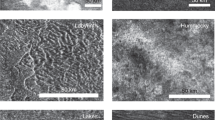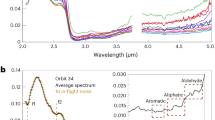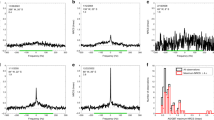Abstract
Titan, the largest moon of Saturn, is the only satellite in the Solar System with a substantial atmosphere. The atmosphere is poorly understood and obscures the surface, leading to intense speculation about Titan's nature. Here we present observations of Titan from the imaging science experiment onboard the Cassini spacecraft that address some of these issues. The images reveal intricate surface albedo features that suggest aeolian, tectonic and fluvial processes; they also show a few circular features that could be impact structures. These observations imply that substantial surface modification has occurred over Titan's history. We have not directly detected liquids on the surface to date. Convective clouds are found to be common near the south pole, and the motion of mid-latitude clouds consistently indicates eastward winds, from which we infer that the troposphere is rotating faster than the surface. A detached haze at an altitude of 500 km is 150–200 km higher than that observed by Voyager, and more tenuous haze layers are also resolved.
This is a preview of subscription content, access via your institution
Access options
Subscribe to this journal
Receive 51 print issues and online access
$199.00 per year
only $3.90 per issue
Buy this article
- Purchase on Springer Link
- Instant access to full article PDF
Prices may be subject to local taxes which are calculated during checkout












Similar content being viewed by others
References
Porco, C. C. et al. Cassini imaging science: Instrument characteristics and anticipated scientific investigations at Saturn. Space Sci. Rev. 115, 363–497 (2004)
McKay, C. P. et al. Temperature lapse rate and methane in Titan's troposphere. Icarus 129, 498–505 (1997)
Samuelson, R. E., Nath, N. R. & Borysow, A. Gaseous abundances and methane supersaturation in Titan's troposphere. Planet. Space Sci. 45, 959–980 (1997)
Lunine, J. I. & Soderblom, L. A. Cassini-Huygens investigations of satellite surfaces and interiors. Space Sci. Rev. 104, 191–208 (2002)
Khare, B. N., Sagan, C., Bandurski, E. L. & Nagy, B. Ultraviolet-photoproduced organic solids synthesized under simulated jovian conditions: Molecular analysis. Science 199, 1199–1201 (1978)
Lunine, J. I., Stevenson, D. J. & Yung, Y. L. Ethane ocean on Titan. Science 222, 1229–1230 (1983)
Smith, P. H., Lemmon, M. T. & Lorenz, R. D. Titan's surface, revealed by HST imaging. Icarus 119, 336–349 (1996)
Coustenis, A. et al. Images of Titan at 1.3 and 1.6 µm with adaptive optics at the CFHT. Icarus 154, 501–515 (2001)
Gibbard, S. G. et al. Speckle imaging of Titan at 2 microns: surface albedo, haze optical depth, and tropospheric clouds. Icarus 169, 429–439 (2004)
Griffith, C. A. et al. Transient clouds in Titan's lower atmosphere. Nature 395, 575–578 (1998)
Rages, K. & Pollack, J. B. Vertical distribution of scattering hazes in Titan's upper atmosphere. Icarus 55, 50–62 (1983)
Raulin, F. & Owen, T. Organic chemistry and exobiology on Titan. Space Sci. Rev. 104, 377–394 (2002)
Richardson, J., Lorenz, R. D. & McEwen, A. Titan's surface and rotation—New insights from Voyager images. Icarus 170, 113–124 (2004)
Griffith, C. A., Owen, T. & Wagener, R. Titan's surface and troposphere, investigated with ground-based, near-infrared observations. Icarus 93, 362–378 (1991)
Brown, M. E., Bouchez, A. H. & Griffith, C. A. Direct detection of tropospheric clouds near Titan's south pole. Nature 420, 795–797 (2002)
Bouchez, A. et al. Keck Observatory Titan monitoring project. http://www2.keck.hawaii.edu/science/titan/ (2005).
Perron, J. T. & de Pater, I. Dynamics of an ice continent on Titan. Geophys. Res. Lett. 31, doi:10.1029/2004GL019802 (2004)
Lorenz, R. D. & Lunine, J. I. Titan's surface before Cassini. Planet. Space Sci. (in the press) (2005)
Griffith, C. A. et al. Evidence for exposure of water ice on Titan's surface. Science 300, 628–630 (2003)
Campbell, D. B. et al. Radar evidence for liquid surfaces on Titan. Science 302, 431–434 (2003)
Lunine, J. I. Does Titan have an ocean? A review of current understanding of Titan's surface. Rev. Geophys. 31, 133–150 (1993)
Lorenz, R. D. Crater lakes on Titan: rings, horseshoes, and bullseyes. Planet. Space Sci. 42, 1–4 (1994)
Zahnle, K., Schenk, P., Levison, H. & Dones, L. Cratering rates in the outer Solar System. Icarus 163, 263–289 (2003)
Dobrovolskis, A. R. & Lissauer, J. J. Fate of ejecta from Hyperion. Icarus 169, 462–473 (2004)
Croft, S. K., Lunine, J. L. & Kargel, J. Equation of state of ammonia-water liquid—Derivation and planetological applications. Icarus 73, 279–293 (1988)
Tokano, T. & Neubauer, F. M. Tidal winds on Titan caused by Saturn. Icarus 158, 499–515 (2002)
Strobel, D. F. Chemistry and evolution of Titan's atmosphere. Planet. Space Sci. 30, 839–848 (1982)
Dimitrov, V. & Bar-Nun, A. Hardening of Titan's aerosols by their charging. Icarus 166, 440–443 (2003)
Hourdin, F. et al. Numerical simulation of the general circulation of the atmosphere of Titan. Icarus 117, 358–374 (1995)
Rannou, P. et al. A coupled dynamics-microphysics model of Titan's atmosphere. Icarus 170, 443–462 (2004)
Lemmon, M. T. et al. HST observations of Titan, 1994–1997: New surface albedo maps and detection of large-scale, sub-tropical cloud activity. Icarus (submitted)
Roe, H. G. et al. Discovery of temperate latitude clouds on Titan. Astrophys. J. 618, L49–L52 (2005)
Rossow, W. B., Del Genio, A. D. & Eichler, T. P. Cloud-tracked winds from Pioneer Venus OCPP images. J. Atmos. Sci. 47, 2053–2084 (1990)
Flasar, F. M., Samuelson, R. E. & Conrath, B. J. Titan's atmosphere: Temperature and dynamics. Nature 292, 693–698 (1981)
Del Genio, A. D., Zhou, W. & Eichler, T. P. Equatorial superrotation in a slowly rotating GCM: Implications for Titan and Venus. Icarus 101, 1–17 (1993)
Del Genio, A. D. & Zhou, W. Simulations of superrotation on slowly rotating planets: Sensitivity to rotation and initial condition. Icarus 120, 332–343 (1996)
Allison, M., Del Genio, A. D. & Zhou, W. Zero potential vorticity envelopes for the zonal-mean velocity of the Venus/Titan atmospheres. J. Atmos. Sci. 51, 694–702 (1994)
Lemmon, M., Smith, P. & Lorenz, R. The evolution of Titan's polar hood near summer solstice. 35th COSPAR Scientific Assembly (Paris, 18–25 July 2004) abstr. COSPAR04-A-04048 (2004)
Hutzell, W. T. et al. Simulations of Titan's brightness by a two-dimensional haze model. Icarus 119, 112–129 (1995)
Hinson, D. P. & Tyler, G. L. Internal gravity waves in Titan's atmosphere observed by Voyager radio occultation. Icarus 54, 337–352 (1983)
Friedson, A. J. Gravity waves in Titan's atmosphere. Icarus 109, 40–57 (1994)
Sicardy, B. et al. The structure of Titan's stratosphere from the 28 Sgr occultation. Icarus 142, 357–390 (1999)
Korycansky, D. G. & Zahnle, K. J. Modeling crater populations on Venus and Titan. Planet. Space Sci. (in the press)
West, R. A. & Smith, P. H. Evidence for aggregate particles in the atmospheres of Titan and Jupiter. Icarus 90, 330–333 (1991)
Sotin, C. et al. Cassini VIMS observations during the October 2004 flyby of Titan: Clues to the dynamics of Titan's surface. Nature (submitted)
Acknowledgements
We acknowledge the many members of the imaging team who have assisted in the design of imaging sequences and camera commands and in other vital operational and image processing tasks, in particular N. Martin, E. Birath, J. Riley, B. Knowles, C. Clark, M. Belanger and D. Wilson. This work has been funded by NASA/JPL, the UK Particle Physics and Astronomy Research Council, the German Aerospace Center (DLR), and Université Paris VII Denis Diderot, CEA, AIM, France.
Author information
Authors and Affiliations
Corresponding author
Ethics declarations
Competing interests
The authors declare that they have no competing financial interests.
Rights and permissions
About this article
Cite this article
Porco, C., Baker, E., Barbara, J. et al. Imaging of Titan from the Cassini spacecraft. Nature 434, 159–168 (2005). https://doi.org/10.1038/nature03436
Received:
Accepted:
Issue Date:
DOI: https://doi.org/10.1038/nature03436
This article is cited by
-
Enceladus and Titan: emerging worlds of the Solar System
Experimental Astronomy (2022)
-
Solar System Science with the Orbiting Astronomical Satellite Investigating Stellar Systems (OASIS) Observatory
Space Science Reviews (2022)
-
Science goals and new mission concepts for future exploration of Titan’s atmosphere, geology and habitability: titan POlar scout/orbitEr and in situ lake lander and DrONe explorer (POSEIDON)
Experimental Astronomy (2022)
-
Multilayer hazes over Saturn’s hexagon from Cassini ISS limb images
Nature Communications (2020)
Comments
By submitting a comment you agree to abide by our Terms and Community Guidelines. If you find something abusive or that does not comply with our terms or guidelines please flag it as inappropriate.



